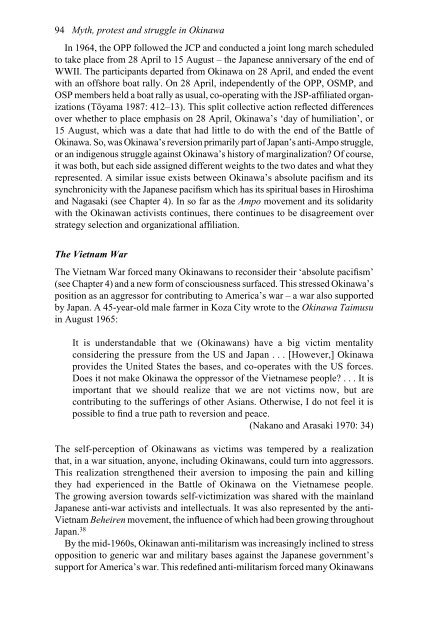Myth, Protest and Struggle in Okinawa
Myth, Protest and Struggle in Okinawa
Myth, Protest and Struggle in Okinawa
Create successful ePaper yourself
Turn your PDF publications into a flip-book with our unique Google optimized e-Paper software.
94 <strong>Myth</strong>, protest <strong>and</strong> struggle <strong>in</strong> Ok<strong>in</strong>awa<br />
In 1964, the OPP followed the JCP <strong>and</strong> conducted a jo<strong>in</strong>t long march scheduled<br />
to take place from 28 April to 15 August – the Japanese anniversary of the end of<br />
WWII. The participants departed from Ok<strong>in</strong>awa on 28 April, <strong>and</strong> ended the event<br />
with an offshore boat rally. On 28 April, <strong>in</strong>dependently of the OPP, OSMP, <strong>and</strong><br />
OSP members held a boat rally as usual, co-operat<strong>in</strong>g with the JSP-affiliated organizations<br />
(Tōyama 1987: 412–13). This split collective action reflected differences<br />
over whether to place emphasis on 28 April, Ok<strong>in</strong>awa’s ‘day of humiliation’, or<br />
15 August, which was a date that had little to do with the end of the Battle of<br />
Ok<strong>in</strong>awa. So, was Ok<strong>in</strong>awa’s reversion primarily part of Japan’s anti-Ampo struggle,<br />
or an <strong>in</strong>digenous struggle aga<strong>in</strong>st Ok<strong>in</strong>awa’s history of marg<strong>in</strong>alization? Of course,<br />
it was both, but each side assigned different weights to the two dates <strong>and</strong> what they<br />
represented. A similar issue exists between Ok<strong>in</strong>awa’s absolute pacifism <strong>and</strong> its<br />
synchronicity with the Japanese pacifism which has its spiritual bases <strong>in</strong> Hiroshima<br />
<strong>and</strong> Nagasaki (see Chapter 4). In so far as the Ampo movement <strong>and</strong> its solidarity<br />
with the Ok<strong>in</strong>awan activists cont<strong>in</strong>ues, there cont<strong>in</strong>ues to be disagreement over<br />
strategy selection <strong>and</strong> organizational affiliation.<br />
The Vietnam War<br />
The Vietnam War forced many Ok<strong>in</strong>awans to reconsider their ‘absolute pacifism’<br />
(see Chapter 4) <strong>and</strong> a new form of consciousness surfaced. This stressed Ok<strong>in</strong>awa’s<br />
position as an aggressor for contribut<strong>in</strong>g to America’s war – a war also supported<br />
by Japan. A 45-year-old male farmer <strong>in</strong> Koza City wrote to the Ok<strong>in</strong>awa Taimusu<br />
<strong>in</strong> August 1965:<br />
It is underst<strong>and</strong>able that we (Ok<strong>in</strong>awans) have a big victim mentality<br />
consider<strong>in</strong>g the pressure from the US <strong>and</strong> Japan . . . [However,] Ok<strong>in</strong>awa<br />
provides the United States the bases, <strong>and</strong> co-operates with the US forces.<br />
Does it not make Ok<strong>in</strong>awa the oppressor of the Vietnamese people? . . . It is<br />
important that we should realize that we are not victims now, but are<br />
contribut<strong>in</strong>g to the suffer<strong>in</strong>gs of other Asians. Otherwise, I do not feel it is<br />
possible to f<strong>in</strong>d a true path to reversion <strong>and</strong> peace.<br />
(Nakano <strong>and</strong> Arasaki 1970: 34)<br />
The self-perception of Ok<strong>in</strong>awans as victims was tempered by a realization<br />
that, <strong>in</strong> a war situation, anyone, <strong>in</strong>clud<strong>in</strong>g Ok<strong>in</strong>awans, could turn <strong>in</strong>to aggressors.<br />
This realization strengthened their aversion to impos<strong>in</strong>g the pa<strong>in</strong> <strong>and</strong> kill<strong>in</strong>g<br />
they had experienced <strong>in</strong> the Battle of Ok<strong>in</strong>awa on the Vietnamese people.<br />
The grow<strong>in</strong>g aversion towards self-victimization was shared with the ma<strong>in</strong>l<strong>and</strong><br />
Japanese anti-war activists <strong>and</strong> <strong>in</strong>tellectuals. It was also represented by the anti-<br />
Vietnam Beheiren movement, the <strong>in</strong>fluence of which had been grow<strong>in</strong>g throughout<br />
Japan. 38<br />
By the mid-1960s, Ok<strong>in</strong>awan anti-militarism was <strong>in</strong>creas<strong>in</strong>gly <strong>in</strong>cl<strong>in</strong>ed to stress<br />
opposition to generic war <strong>and</strong> military bases aga<strong>in</strong>st the Japanese government’s<br />
support for America’s war. This redef<strong>in</strong>ed anti-militarism forced many Ok<strong>in</strong>awans
















